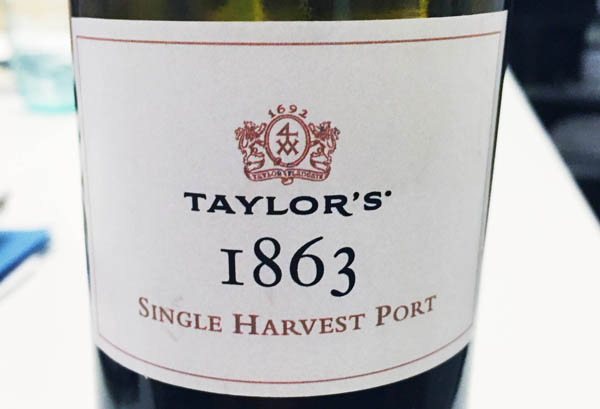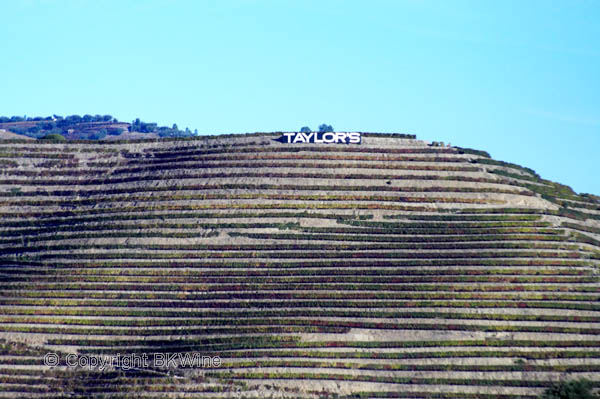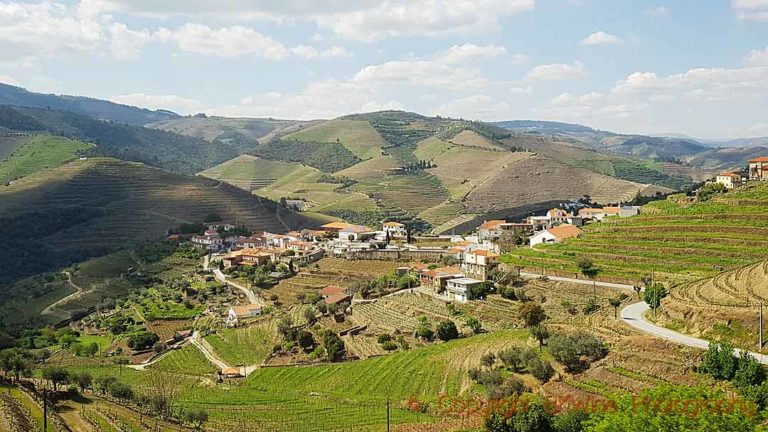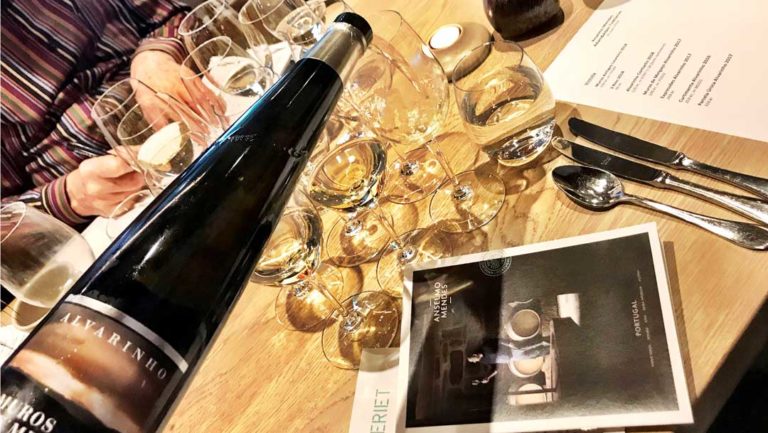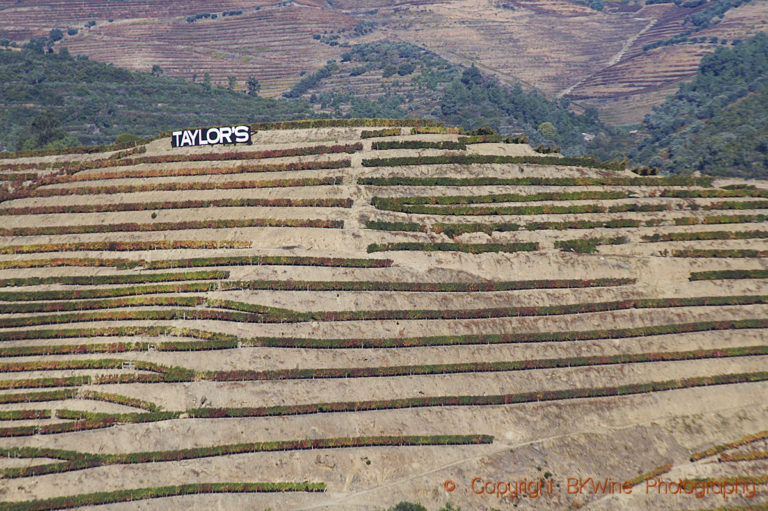Taylor’s, a port house with a history and with plenty of good bottles
We are many who uncork a bottle of port wine for Christmas. But port is a wine that is really nice the rest of the year too. Taylor’s is one of the most famous port wine houses, with a long history and many exciting wines in their range. Everything from young and modest ruby port to 151 years old tawny that you drink with awe. BKWine Magazine’s reporter Wilhelm Arnör met Taylor’s export manager Jorge Ramos when he came to Stockholm to present a collection of port wines, ranging from young and powerful vintage ports, over a series of delicious tawnies and fruity Late Bottled Vintage to a venerable antique, a port from 1863!
Taylor’s export manager Jorge Ramos was in Stockholm recently to present Taylor’s port with the broadest selection of port wines that I have ever had the opportunity to taste. From Taylor’s Vintage Port 2011 to Taylor’s Single Harvest 1863. 1863! 90 years before my birth!
Taylor, Fladgate & Yeatman, or as they now prefer to call themselves, Taylor’s, was already before the tasting one of my own favourite producers. They have long been making top quality and has since the 90’s ambitiously invested in both new plantings as well as in new facilities. The production is however kept as artisanal as possible. The biggest change is that it is now permitted to use wine spirits of any provenance as fortification although Taylor’s using 60 % distilled from wine from Portugal which has stabilised quality significantly.

Vineyards from A to F
It is evident that this is a firm that is doing well and that is run professionally. The Douro region is about 150 kilometres east of the harbour city of Porto. The area was mapped out already in 1756 and was divided into three areas Baixa Corgo, Cima Corgo, Douro Superior. Cima Corgo is considered as the most qualitative of them and most of Taylor’s vineyards are there.
Each vineyard is rated in a quality grade depending on the distance to the river, altitude, age of the vines, etc. They are grouped from A to F. Taylor’s only have A quality. Many of vineyards are terraced but on grades of less than 40% the planting can be done vertically. The advantage of this is a higher planting density. When replanting on steep slopes they make terraces with the help of a special laser-guided excavator. It creates terraces which are slightly sloped inward (7°) so that any rainfall is retained on each terrace instead of eroding the slope.
Soils are mainly slate soil with vertical cracks and only a thin layer of topsoil. Thus a good drainage, forcing the vine to send roots deep down to get water.
In addition to erosion the second major challenge in the Douro is weed control. Taylor’s has solved it so that they do not need to spray weed killer, instead they plant their vineyards with cover crops that outcompete with the unwanted weeds but not with the vines. In addition, its roots bind the thin top soil.
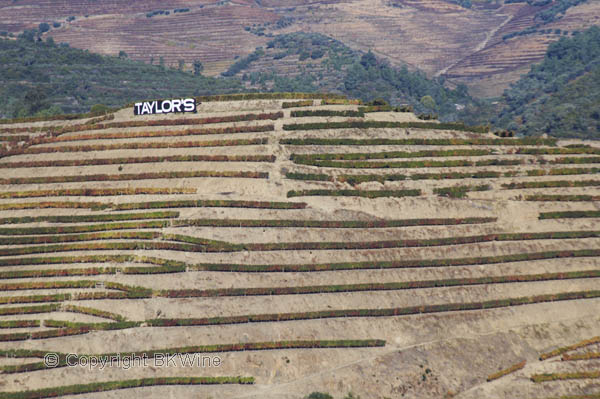
The harvest is usually concentrated to 3 weeks starting in late September. During the harvest they employ some 450 people. Everything is picked by hand. Earlier ripening grape varieties are planted higher up so they can harvest over a very short time period. Taylor’s also in that they crush grapes with traditional foot-treading!
The wines
Our “menu” includes all types of port with the exception of ruby port, the simplest version which is in barrel maybe 3 years and consumed young. The other types of port are expected to age considerably longer before we drink them.

Late Bottled Vintage and old tawny
Our first flight includes Taylor’s Late Bottled Vintage 2009, Taylor’s 10 years old tawny and Taylor’s 20 years old tawny.
Late Bottled Vintage (LBV) is a style created by Taylor in 1970 using the 1965 harvest. Its purpose then and now is to fill the gap between different port types by using wines from good years, essentially of vintage quality, and to keep them longer in barrels, 4-6 years, filter, stabilize and bottle them for consumption. Jorge believes that LBV does not benefit from cellaring by the consumer.
In the glass (Taylor’s Late Bottled Vintage 2009) I have a young supple wine almost black in colour lovely aromas of plum, more dark berries, tobacco and liquorice. The taste is young, tannic, lots of plums, a little bitter liquorice and almost a bit prickly, medium length and good balance. Bottled this year. Affordable at under 20 euro. I still think some time in the cellar would make this wine even more enjoyable.

Taylor’s 10 years old tawny is its opposite, very beautiful amber colour, wonderfully rich, powerful, complex aroma. A big and elegant nose with notes of sweets such as chocolate, caramel, nuts, roasted almonds. The taste is powerful, long, a combination of figs, nuts and almonds and marzipan and despite it being a fortified wine the taste is soft and round. Beautifully balanced. Taylor’s is understood aim at making uniform each blend. It should be composed of many different (20-30) wines, of on average 10 years old wines from different barrels (vineyards). But the age range can be great.
Tawny is a wine aged in smaller barrels (600 litres) until the barrel is selected for a blend. And the fact is that everything is aged in barrels until an order comes in. So when an order arrives they blend a batch of 10-year-old tawny and then dispatch it. The blend is basically different each time.
Next glass is a Taylor’s 20 years old tawny, even a little lighter in colour and a little browner than its 10-years-old siblings, a little more depth on the nose but slightly more bitter almonds and acidity in the aftertaste. Also a very good wine, but I prefer the 10-years version not least in light of the 10-year costs (~26 euro) while the 20-year-old is twice as expensive!

Vintage Ports
Round two consists of 5 pieces of vintage port, the port with only two years in barrel and the rest of the bottle. A completely different type of port that is.
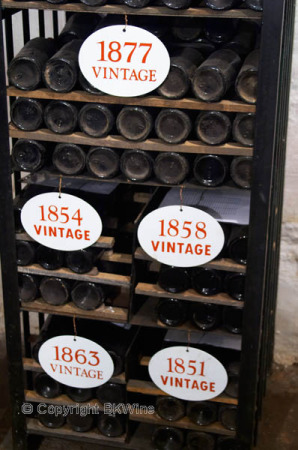
We begin with Taylor’s vintage 1997, still dark in the glass with small age-related changes in colour. Rich mellow aroma of chocolate, plum, and barrel. Complex and balanced, nice full-bodied flavour that develops in the mouth, hint of “cough syrup” but very good length. A good vintage port wine that still feels young.
Even younger and my favourite of all is the next wine, Taylor’s Vintage Port 2000. In character like the 97 but slightly more mature and its fruit is unsurpassed. The fruity, aromatic scent makes it feel both mature and youthful at the same time. The taste is fruity, vigorous, rich, elegant and complex, and fills the mouth for a long time. This wine when available would cost around 90 euro for a whole bottle, which would be well worth the coins.
So, 2003, Taylor’s Vintage Port 2003, that is the next wine shows a little disappointing. A well-made and nice wine but in my opinion not at all with the same length but fades quickly and folds down.
Possibly this is partially because the wine number four is another high quality vintage wine from a single Quinta (vineyard), Quinta de Vargellas Vinha Velha 2007. Taylor’s started making this in the mid 90s. Some years when they have a large enough harvest they take grapes from very old vines (up to 100 years) of high quality and make this separate vintage. The colour is black that tapers off at the edge. The nose is big, powerful, and a little fiery, typical barrel and vanilla perfume with different scents of chocolate, tobacco, and spices, especially cloves. The taste is tannic and big, still young and closed, more backward than the smell but full of promise. A great wine but priced at double (~190 euro). Good value for money? The future will give the answer.
The flight ends with Taylor’s Vintage Port 2011. Definitely perceived as the youngest but still with a lovely generous berry nose with blueberries and blackberries, a little floral and tannic, astringent, sweet fruity and fortified wine character. Something to buy (~70 euro) children and grandchildren or earmark for your own Christmas, perhaps in 2044.
Vintage tawny = colheita
The last flight contains two so-called colheitas, ie port from a single vintage aged in the barrel all the time until (late) bottling. A “single vintage tawny” in other words.
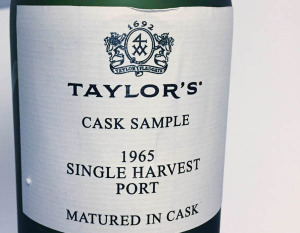
The first is Taylor’s Single Harvest 1965 that was kept in the barrel until Taylor’s decided to bottle and sell it to, for example for the benefit of 50-year anniversaries. In total there are three vintages of barrel aged wines (1964, 1965 and 1966) which, instead of being part of a 40 year old tawny now is bottled on their own merits. For only 180 euros or so it can be had on anyone who wants to enjoy a port as old as himself. Brown-gold coloured the ’65 exhibits an exciting registers, deep sweetness contrasts with the high acid with hints of vinegar tones, the taste is warm, full-bodied, ripe, hints of almonds and cinnamon. Everything in good balance.
Finally we are approaching today’s gem, Taylor’s Single Harvest 1863. Someone asks for a perspective on the year. This wine was made the same year as the Battle of Gettysburg! Or the same year as the London Underground started, Henry Ford was born, etc. 151 years ago! Someone else asks “How much is left of the original wine?” Jorge says that average evaporation from a barrel is 3% of the volume of each year, ie 0.97 remains of the original volume. Next year it is 0.97 * 0.97 left, in other words, one can express it mathematically: 0.97 ^ 151 = 0,010. The centilitre that we get in the glass is thus what remains of a litre of port wine in 1863.
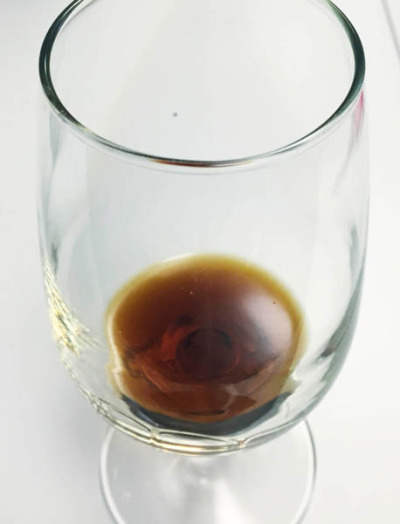
The 34 euros that my centilitre of Taylor’s Single Harvest 1863 cost is worth every drop. The colour is mahogany brown that turns into gold edges. The aroma is rich and full-bodied, balanced with soft aromas of fruits such as peach, canned plum and ripe aromas of nuts and butter toffee, acidity is brilliant. The flavour is intense, very concentrated, slightly viscous and complex with accentuated acidity. It is enough with only a few drops at a time to fill the entire palate with these flavours. But the aromas in the nose is what I will remember from this pre-phylloxera wine.
Friday afternoon is finished. As one of the participants put it “this is what I call Friday fun”. One can only agree. A lovely exposé of port wine at its best. The stilton which was then served was so good that we quickly decide to eat and drink anything that remains. On the way out, I decide that this Christmas we will have a 10 years tawny port but a few vintage 2000 and 2007 should perhaps be laid down in the cellar for future Christmases.
The tasting was organized by Vinunic, Taylor’s Swedish importer.
Wilhelm Arnör writes on wine on BKWine Magazine. Wilhelm has been a dedicated wine enthusiast ever since he founded Vincollegiet, a still active wine tasting association at the Royal Institute of Technology (KTH) in Stockholm, in 1976. His day job is running a company in the IT business in Sweden.
[box type=”info” style=”rounded” border=”full”]There is a breadth and depth in the range of port wine that one might not expect. The best way to discover all the great port wines is on site, not to forget the excellent table wines, on a wine tour in the Douro Valley with BKWine.
Travel to the world’s wine regions with the experts on wine and the specialist on wine tours.
Wine tours in a way that no one else can.[/box]
